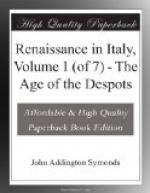The word Renaissance has of late years received a more extended significance than that which is implied in our English equivalent—the Revival of Learning. We use it to denote the whole transition from the Middle Ages to the Modern World; and though it is possible to assign certain limits to the period during which this transition took place, we cannot fix on any dates so positively as to say—between this year and that the movement was accomplished. To do so would be like trying to name the days on which spring in any particular season began and ended Yet we speak of spring as different from winter and from summer. The truth is, that in many senses we are still in mid-Renaissance. The evolution has not been completed. The new life is our own and is progressive. As in the transformation scene of some great Masque, so here the waning and the waxing shapes are mingled; the new forms, at first shadowy and filmy, gain upon the old; and now both blend; and now the old scene fades into the background; still, who shall say whether the new scene be finally set up?
In like manner we cannot refer the whole phenomena of the Renaissance to any one cause or circumstance, or limit them within the field of any one department of human knowledge. If we ask the students of art what they mean by the Renaissance, they will reply that it was the revolution effected in architecture, painting, and sculpture by the recovery of antique monuments. Students of literature, philosophy, and theology see in the Renaissance that discovery of manuscripts, that passion for antiquity, that progress in philology and criticism, which led to a correct knowledge of the classics, to a fresh taste in poetry, to new systems of thought, to more accurate analysis, and finally to the Lutheran schism and the emancipation of the conscience. Men of science will discourse about the discovery of the solar system by Copernicus and Galileo, the anatomy of Vesalius, and Harvey’s theory of the circulation of the blood. The origination of a truly scientific method is the point which interests them most in the Renaissance. The political historian, again, has his own answer to the question. The extinction of feudalism, the development of the great nationalities of Europe, the growth of monarchy, the limitation of the ecclesiastical authority and the erection of the Papacy into an Italian kingdom, and in the last place the gradual emergence of that sense of popular freedom which exploded in the Revolution; these are the aspects of the movement which engross his attention. Jurists will describe the dissolution of legal fictions based upon the false decretals, the acquisition of a true text of the Roman Code, and the attempt to introduce a rational method into the theory of modern jurisprudence, as well as to commence the study of international law. Men whose attention has been turned to the history of discoveries and inventions will relate the exploration of America and the East, or will point to the benefits conferred




